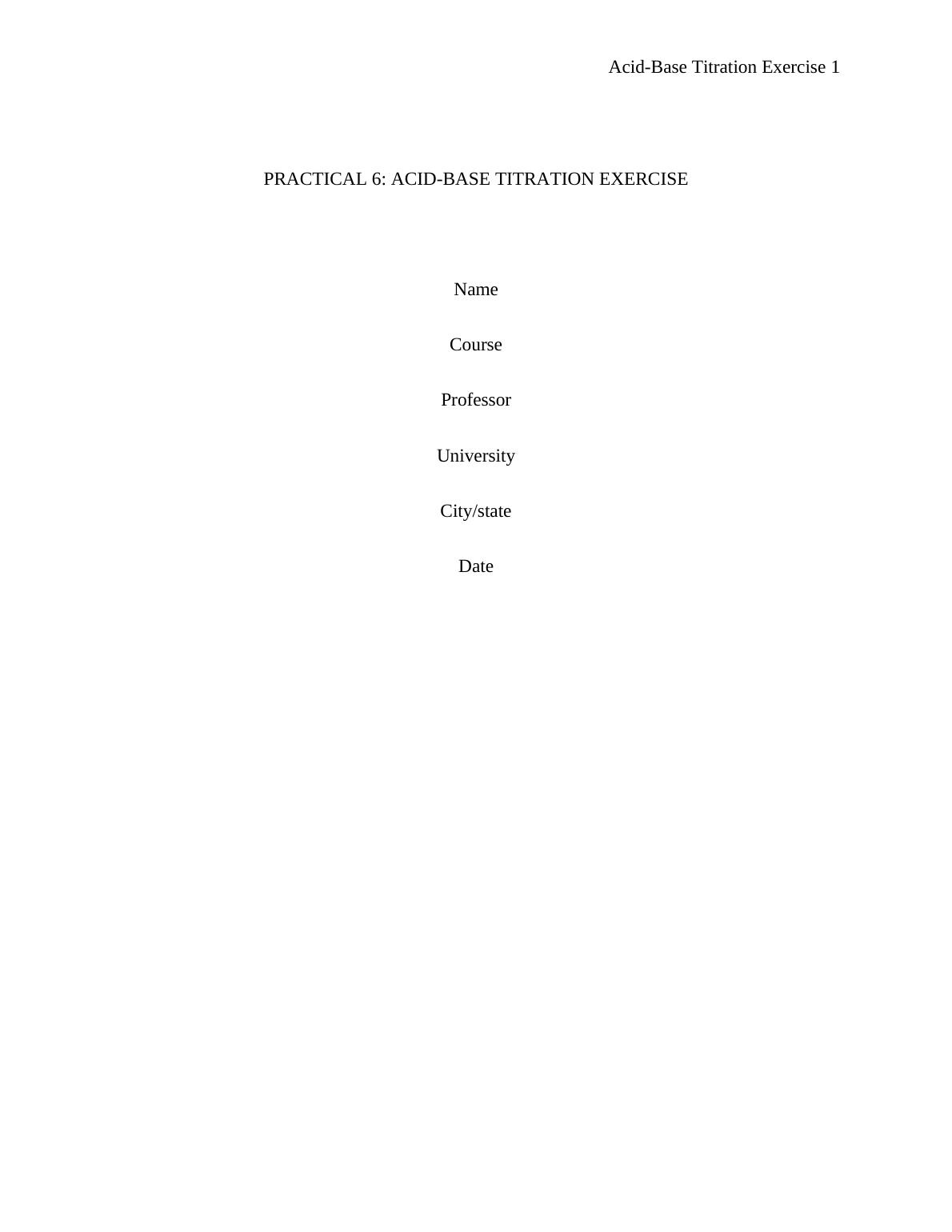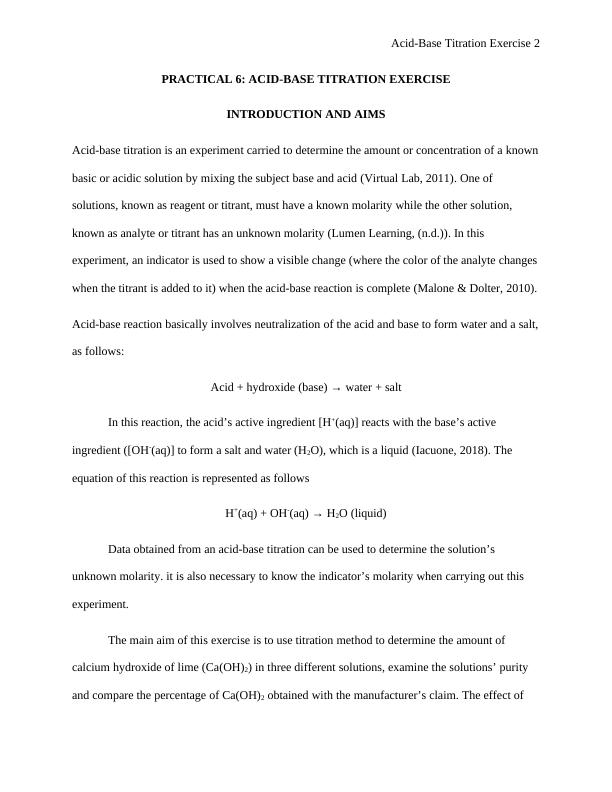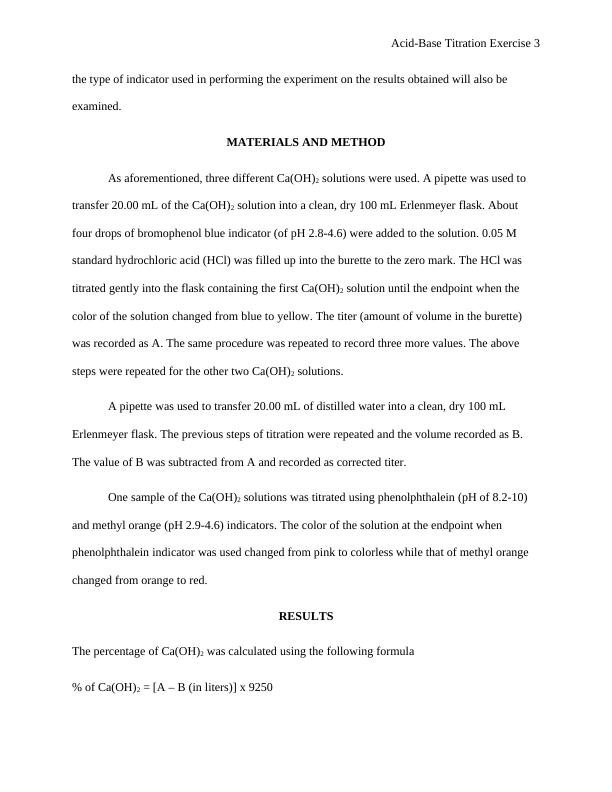Acid-Base Titration Exercise
Added on 2023-03-30
7 Pages1302 Words220 Views
Acid-Base Titration Exercise 1
PRACTICAL 6: ACID-BASE TITRATION EXERCISE
Name
Course
Professor
University
City/state
Date
PRACTICAL 6: ACID-BASE TITRATION EXERCISE
Name
Course
Professor
University
City/state
Date

Acid-Base Titration Exercise 2
PRACTICAL 6: ACID-BASE TITRATION EXERCISE
INTRODUCTION AND AIMS
Acid-base titration is an experiment carried to determine the amount or concentration of a known
basic or acidic solution by mixing the subject base and acid (Virtual Lab, 2011). One of
solutions, known as reagent or titrant, must have a known molarity while the other solution,
known as analyte or titrant has an unknown molarity (Lumen Learning, (n.d.)). In this
experiment, an indicator is used to show a visible change (where the color of the analyte changes
when the titrant is added to it) when the acid-base reaction is complete (Malone & Dolter, 2010).
Acid-base reaction basically involves neutralization of the acid and base to form water and a salt,
as follows:
Acid + hydroxide (base) → water + salt
In this reaction, the acid’s active ingredient [H+(aq)] reacts with the base’s active
ingredient ([OH-(aq)] to form a salt and water (H2O), which is a liquid (Iacuone, 2018). The
equation of this reaction is represented as follows
H+(aq) + OH-(aq) → H2O (liquid)
Data obtained from an acid-base titration can be used to determine the solution’s
unknown molarity. it is also necessary to know the indicator’s molarity when carrying out this
experiment.
The main aim of this exercise is to use titration method to determine the amount of
calcium hydroxide of lime (Ca(OH)2) in three different solutions, examine the solutions’ purity
and compare the percentage of Ca(OH)2 obtained with the manufacturer’s claim. The effect of
PRACTICAL 6: ACID-BASE TITRATION EXERCISE
INTRODUCTION AND AIMS
Acid-base titration is an experiment carried to determine the amount or concentration of a known
basic or acidic solution by mixing the subject base and acid (Virtual Lab, 2011). One of
solutions, known as reagent or titrant, must have a known molarity while the other solution,
known as analyte or titrant has an unknown molarity (Lumen Learning, (n.d.)). In this
experiment, an indicator is used to show a visible change (where the color of the analyte changes
when the titrant is added to it) when the acid-base reaction is complete (Malone & Dolter, 2010).
Acid-base reaction basically involves neutralization of the acid and base to form water and a salt,
as follows:
Acid + hydroxide (base) → water + salt
In this reaction, the acid’s active ingredient [H+(aq)] reacts with the base’s active
ingredient ([OH-(aq)] to form a salt and water (H2O), which is a liquid (Iacuone, 2018). The
equation of this reaction is represented as follows
H+(aq) + OH-(aq) → H2O (liquid)
Data obtained from an acid-base titration can be used to determine the solution’s
unknown molarity. it is also necessary to know the indicator’s molarity when carrying out this
experiment.
The main aim of this exercise is to use titration method to determine the amount of
calcium hydroxide of lime (Ca(OH)2) in three different solutions, examine the solutions’ purity
and compare the percentage of Ca(OH)2 obtained with the manufacturer’s claim. The effect of

Acid-Base Titration Exercise 3
the type of indicator used in performing the experiment on the results obtained will also be
examined.
MATERIALS AND METHOD
As aforementioned, three different Ca(OH)2 solutions were used. A pipette was used to
transfer 20.00 mL of the Ca(OH)2 solution into a clean, dry 100 mL Erlenmeyer flask. About
four drops of bromophenol blue indicator (of pH 2.8-4.6) were added to the solution. 0.05 M
standard hydrochloric acid (HCl) was filled up into the burette to the zero mark. The HCl was
titrated gently into the flask containing the first Ca(OH)2 solution until the endpoint when the
color of the solution changed from blue to yellow. The titer (amount of volume in the burette)
was recorded as A. The same procedure was repeated to record three more values. The above
steps were repeated for the other two Ca(OH)2 solutions.
A pipette was used to transfer 20.00 mL of distilled water into a clean, dry 100 mL
Erlenmeyer flask. The previous steps of titration were repeated and the volume recorded as B.
The value of B was subtracted from A and recorded as corrected titer.
One sample of the Ca(OH)2 solutions was titrated using phenolphthalein (pH of 8.2-10)
and methyl orange (pH 2.9-4.6) indicators. The color of the solution at the endpoint when
phenolphthalein indicator was used changed from pink to colorless while that of methyl orange
changed from orange to red.
RESULTS
The percentage of Ca(OH)2 was calculated using the following formula
% of Ca(OH)2 = [A – B (in liters)] x 9250
the type of indicator used in performing the experiment on the results obtained will also be
examined.
MATERIALS AND METHOD
As aforementioned, three different Ca(OH)2 solutions were used. A pipette was used to
transfer 20.00 mL of the Ca(OH)2 solution into a clean, dry 100 mL Erlenmeyer flask. About
four drops of bromophenol blue indicator (of pH 2.8-4.6) were added to the solution. 0.05 M
standard hydrochloric acid (HCl) was filled up into the burette to the zero mark. The HCl was
titrated gently into the flask containing the first Ca(OH)2 solution until the endpoint when the
color of the solution changed from blue to yellow. The titer (amount of volume in the burette)
was recorded as A. The same procedure was repeated to record three more values. The above
steps were repeated for the other two Ca(OH)2 solutions.
A pipette was used to transfer 20.00 mL of distilled water into a clean, dry 100 mL
Erlenmeyer flask. The previous steps of titration were repeated and the volume recorded as B.
The value of B was subtracted from A and recorded as corrected titer.
One sample of the Ca(OH)2 solutions was titrated using phenolphthalein (pH of 8.2-10)
and methyl orange (pH 2.9-4.6) indicators. The color of the solution at the endpoint when
phenolphthalein indicator was used changed from pink to colorless while that of methyl orange
changed from orange to red.
RESULTS
The percentage of Ca(OH)2 was calculated using the following formula
% of Ca(OH)2 = [A – B (in liters)] x 9250

End of preview
Want to access all the pages? Upload your documents or become a member.
Related Documents
Lab Report on Neutralization Reaction 2022lg...
|7
|1698
|24
Experiment to determine the amount of acetic acid in a white and apple vinegarlg...
|13
|2264
|191
Chemistry Study Materiallg...
|4
|602
|73
Acids Bases and Salt Assignment 2022lg...
|10
|2576
|24
Analysis of an Antacid Lab 2022lg...
|7
|1670
|27
Practical Experiment for Acid-Base Titrationlg...
|11
|1477
|382
